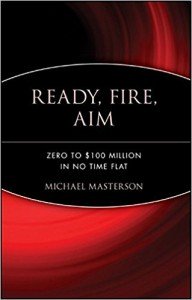 Book title: Ready, fire, aim
Book title: Ready, fire, aim
Author: Michael Masterson (aka Mark Ford)
ISBN-10: 0470182024
ISBN-13: 978-0470182024
Buy here
What this book is about
Ready, fire, aim is not a typo. It is a deliberate word play on the common phrase Ready, aim, fire. Written by Michael Masterson, this book describes the process of building a company right from the startup phase to an enterprise that earns millions of dollars. The title suggests that we should always start before we are fully ready to launch something and that we should never obsess to the point of perfection. By launching before the product is perfect, we are letting the market decide how to improve it rather than falling into the trap of hubris, where we falsely believe that we fully know the market.
In the book, Michael breaks down the lifetime of a company into five stages. The sections of the book focus on what to do and where you should focus during those five stages.
Stage 1: Bootstrap
In stage 1, your company should focus on selling one — yes, exactly ONE — product. And remember, follow the Ready, fire, aim process. You cannot make the product perfect. You have to make it reasonably competent. The product should have at least one thing which is different from whatever is in the market, even if it means an imitation product at a price cheaper than that of the competition.
Only a fraction of your focus should be on product development. Instead, your company should be heavily focus on selling one product really well. You should become an expert at copy writing, advertising your product’s USP, direct marketing, closing sales and other skills related to marketing and sales. You should test different messages on different media of advertising and hang onto the ones that work the best.
Stage 1’s main goal is to acquire as many customers as possible at as low a cost per customer in the hope that some of them will buy from you on a repeated basis. Acquiring more customers will also ensure that your company’s lifeline is ensured: cashflow.
One important point that Michael makes is that anything not directly affecting sales should be completely deferred during stage 1, because you don’t have the money to spend. That means deferring the following: buying office furniture, finalising legal documents, printing visiting cards and upgrading to latest hardware.
Stage 2: Growth
It doesn’t matter how ground-breaking or popular your first product is. There will be a point where everyone who wants that product already has it and the others don’t want it. It’s pointless to try to shove your product down the throat of someone who doesn’t want it. Naturally, sales will plateau and even drop.
This is the time when you start introducing new products to the market. In stage 2, it is time to be a product innovator and manager. Your role is to be tuned to the market for various desires that are not being fulfilled. Here is where Michael makes a distinction between needs and desires. It is rare that you will become profitable by selling needs, because needs will often become commodities sold by multiple vendors and with a very little profit margin. However desires can be tapped into and the right type of customers found to make your business profitable. Even when selling needs like food and clothing, you can find out desires such as the crunchiest cabbages or the softest fabric.
You should ideate and launch as many new products as you possibly can to the best of your capacity. You should test the market before creating the perfect product and launch them before they are perfect. Some of your products will inevitably fail. Here is another seemingly contradictory advice from Michael, but it makes sense. “If a product is broken, then don’t fix it. If it isn’t broken, then fix it.” You should resist the temptation to tweak a product that is failing in the market. The market doesn’t want it and you should quietly phase it out. However if a product is a hit with the market, you must look for ways to improve it such that it becomes irresistible. Think of the most successful smartphones. Listen to market feedback or new desires and tweak products one change at a time, so that each product becomes better over time.
Stage 3: Organisation
Once your company grows, it becomes necessary to introduce processes and documentation around everything. The company needs to be organised into a hierarchy. Without a hierarchy and a process, there will be problems and chaos, with no one knowing their responsibilities and being held accountable. Activities won’t be tracked and problems will slip through the cracks. Customers will notice the problems as faults start to trickle towards them. There may be defective products, an unresponsive customer service, delayed or forgotten deliveries, failed payments and requests for returns.
Michael suggests breaking up the staff into departments, some of them being profit centres and others being for operations. Profit centres are departments that are responsible for creation and sales of products, such as technology & innovation, design and marketing. Operations are responsible for running the business on a day to day basis, e.g. finance, legal, order & fulfilment, resource management, human resources, etc.
You must track your business once in a while to see how the most important numbers are faring. Every manager who reports to you should present you with 3 (not more) numbers that indicate how his/her department has performed. These numbers should be bench-marked and tracked month-on-month. Using them, you can appraise good employees and deal with non-performing ones.
Stage 4: Hiring and grooming star employees
As the company grows and starts running on its own, your focus will be on setting other businesses, each going through their own 5 stages. You should start taking less responsibilities and hiring more people to work for you.
Among the most important employees that you hire are the ones with their own entrepreneurial mindset. Hired to establish processes for you in stage 3, some of them will want to take on more responsibilities and want to implement their own ideas for the company. This is a good thing, since they will bring their own genius to make more profits for the company.
Star employees are qualified to be entrepreneurs in their own right, but are looking for stability and a steady income, relying on you to take the risk of huge investments into the company. Eventually star employees may move away as their confidence and risk appetite grows. But you must constant look for and hire such employees.
Looking for star employees needs you to be more involved in the hiring process, which means moving away from the typical process of letting your human resource department hire to the specification of a job description. Star employees are more picky about where they join, so you need to instil the confidence that tells them that they can grow their career at your company. You will need to talk to them personally about their career goals and how your company can help.
Stage 5: Moving out of the way
At one point, the company outgrows the capacity of your entrepreneurial capabilities. You are just one man/woman with limits on how much you can bring to the table and how much you can comprehend the business you are running. Often, the star employees will have taken the company in a whole new direction out of your understanding. Trying to head the company will put you in the way of the company’s growth.
It is best to pass the helm to a star employee. You may also split your company into different units and give more than one of your star employees the chance to head a company. Your role is that of an investor and either as a sole consultant or as an advisor in a panel. You will still pump the money and take the investment risk, but you will no longer run the company on a day-to-day basis. Only step in when you see the company’s principles or vision being violated or when your star employees ask for your help.
Conclusion
Ready, fire, aim is a compelling blueprint on how to start your company. It teaches what role your employees and you should play during each stage of growth. You can read this book in one go. Better yet, read it only one section at a time as you set up your company and hit the different stages. Either way, this book is as good as business / entrepreneurship counselling for a fraction of the price. It is a must-read if you have always been dreaming of having your own start-up.

We know you love books. We would you like to give two FREE audio books. Grab your trial Audible Membership with Two Free Audio Books . Cancel at anytime and retain your books.
That’s true. You can read a section, apply it to your business, test it and only then move on to the next section. In fact, you can do that para by para too!
This book tends to be somewhere between a manual and a playbook for building a business. Reading it as per the stage one is in is a very wise advice. Chew only as much as is required.